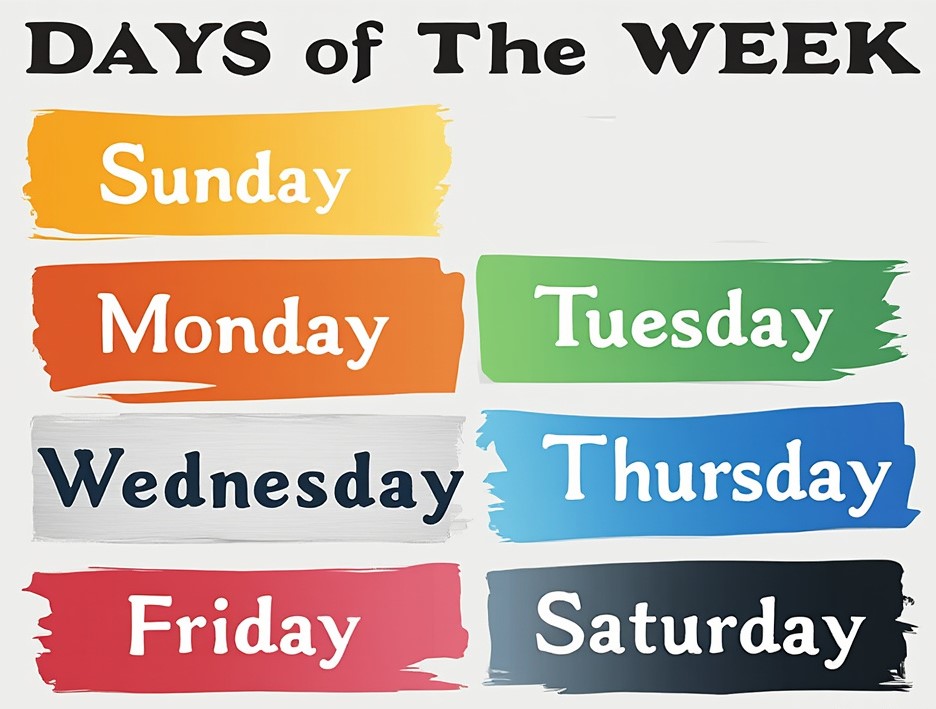Understanding the cultural and linguistic significance of the days of the week can enrich language learning in the TESOL (Teaching English to Speakers of Other Languages) classroom. Each day of the week is rooted in ancient mythologies, with deities from Roman, Norse, and other traditions symbolizing the characteristics of each day. By incorporating the symbolism and cultural background of the days into lessons, teachers can create a unique and engaging learning experience for students.
The Days of the Week: Origins and Symbolism
- Monday (Moon’s Day)
- Deity: The Moon (Luna in Roman mythology, Mani in Norse mythology).
- Symbolism: Intuition, emotions, cycles, reflection.
- Teaching Tip: Use Monday’s association with the Moon and reflection to introduce reflective writing exercises or discussions about personal routines. Discuss cultural associations with the Moon in various countries.
- Tuesday (Tiw’s Day or Mars’ Day)
- Deity: Tyr (Norse god of war and justice) or Mars (Roman god of war).
- Symbolism: Courage, strength, justice, and conflict.
- Teaching Tip: On Tuesdays, consider introducing debates or topics related to conflict resolution. Discuss idioms related to strength and justice, or explore cultural expressions of courage.
- Wednesday (Woden’s Day or Mercury’s Day)
- Deity: Odin (Norse god of wisdom and magic) or Mercury (Roman god of communication and travel).
- Symbolism: Communication, wisdom, learning, travel.
- Teaching Tip: Wednesday is an ideal day to focus on communication skills. Use activities that emphasize dialogue, conversation practice, or problem-solving. Explore how language and wisdom are connected in different cultures.
- Thursday (Thor’s Day or Jupiter’s Day)
- Deity: Thor (Norse god of thunder) or Jupiter (Roman king of the gods, associated with thunder and the sky).
- Symbolism: Power, protection, leadership, expansion.
- Teaching Tip: Incorporate leadership-based activities, such as role-playing or group projects. Discuss idioms like “throwing thunder” or other expressions of power and authority in English.
- Friday (Frigg’s Day or Venus’ Day)
- Deity: Frigg (Norse goddess of love and fertility) or Venus (Roman goddess of love and beauty).
- Symbolism: Love, beauty, harmony, relationships.
- Teaching Tip: Use Friday to explore language related to emotions, relationships, or artistic expression. Encourage students to write love poems, describe their favorite art, or discuss cultural views on love and beauty.
- Saturday (Saturn’s Day)
- Deity: Saturn (Roman god of time and harvest).
- Symbolism: Time, discipline, structure, responsibility.
- Teaching Tip: Focus on time management, organization, and discipline-related language. Introduce vocabulary related to schedules, planning, and personal responsibility.
- Sunday (Sun’s Day)
- Deity: The Sun (associated with many deities, such as Sol in Roman mythology and Ra in Egyptian mythology).
- Symbolism: Light, energy, vitality, creation.
- Teaching Tip: Use Sunday’s themes of light and energy to introduce creative projects. Encourage storytelling, art-based assignments, or discussions about hopes, dreams, and creativity.
How to Use the Days of the Week in TESOL Teaching
- Cultural Context Lessons:
Introduce students to the cultural history behind each day of the week. Compare how different cultures have adopted the names and symbolism of the days. This can be a great way to teach vocabulary related to mythology, history, and culture. - Storytelling and Writing Prompts:
Use the symbolism associated with each day to create writing or storytelling prompts. For example, on Wednesday, students could write a story about a journey or communication. On Friday, they could describe their idea of beauty or relationships. - Thematic Vocabulary Practice:
Design vocabulary lessons around the symbolism of each day. For example, focus on travel-related words on Wednesday (Mercury’s day) or emotional vocabulary on Friday (Venus’ day). - Weekly Language Goals:
Create weekly themes based on the symbolism of each day to reinforce learning goals. For example, Monday could be about self-reflection and discussing feelings, while Tuesday could focus on assertiveness and expressing opinions. - Debates and Discussions:
On Tuesdays (associated with war and justice), students can practice debating skills. Give them topics that involve decision-making or conflict resolution, which ties into the day’s symbolism of courage and justice. - Cross-Cultural Comparisons:
Discuss with students how different cultures view the days of the week. Some countries, for example, have different names for the days, reflecting their own historical or religious figures. This helps students develop a global understanding of language and culture. - Integrating Idioms and Expressions:
Teach idiomatic expressions related to the days of the week, like “Blue Monday” or “Thank God It’s Friday (TGIF).” These can be fun ways for students to learn how language reflects daily life and emotions. - Language and Astrology:
Some students may be interested in astrology, where days of the week also have symbolic meanings. Exploring this connection can be an engaging way to discuss how language reflects personal identity, emotions, and cultural beliefs.
Conclusion
Using the days of the week and their historical and symbolic backgrounds can provide a rich, engaging context for teaching English to language learners. Not only does it introduce students to new vocabulary and cultural references, but it also ties language learning to universal themes such as communication, courage, love, and discipline. By incorporating these elements into the TESOL classroom, teachers can create meaningful, thematic lessons that resonate with students and enrich their learning experience.


